2011 BMW Alpina B7 - Click above for high-res image gallery
Alpina is as familiar to German enthusiasts as Shelby, Hurst, Saleen and Yenko are to American gearheads. And like its American counterparts, Alpina has made a business out of taking the best vehicles from one marque and making them substantially better than anything rolling off the assembly line.
The relationship between BMW and Alpina started in 1962 when a German enthusiast named Burkard Bovenseipen realized his BMW 1500 had plenty of untapped potential. Bovenseipen developed a dual carburetor kit for the 1500's four-cylinder, and as the carbs flew off the shelves, he realized there was a serious market for BMW-based performance parts. Mr. B formed ALPINA Burkard Bovenseipen KG in 1964 and in the decades since, the company has become known simply as Alpina.
But while the name has changed, its mission remains the same, and its line of upgrades have grown considerably since its inception. Bovenseipen's team continues to recognize the potential in almost every new BMW product, and the small but competent company, now managed by Bovenseipen's son Andreas (his staff calls him Andy), delivers better, less compromised, higher-performance versions of BMW production cars.
In Europe, Alpina offers variants of the 3 Series, 5 Series and 6 Series, dubbed the B3, B5, and B6, respectively. However, production constraints (and some concerns about M cannibalization, we're sure) prevents sales of these hotted-up Bimmers in the States. That's a crime, because the Alpina B7 – the only Alpina available in the U.S. – is easily the best 7 Series we've driven.
Photos by Rex Roy / Copyright ©2010 Weblogs, Inc.
For the 2011 model year, there are four derivatives of the B7 available in the States: the B7, B7 L (long wheelbase), B7 xDrive (all-wheel drive), and B7 L xDrive. All feature generally the same equipment.
Exterior changes are limited, but critical. The front and rear fascias are new, and the entire body sits lower (15 mm in front and 10 mm in the rear) over Alpina 20-spoke, 21-inch wheels. Andy Bovenseipen explained that the wheels with 18 or 20 spokes manifest the ideal balance of maximum strength with minimal weight, which is why Alpina has used almost the exact same design for decades. But Alpina didn't just throw on a pair of new hoops and call it a day – nestled within the wheel's center cab is the valve stem, with air traveling through a single hollow spoke to inflate the tire. As is always the case with Alpina, it's the details that matter.
The subtle exterior changes are more than cosmetic. The front air dam directs air toward the additional coolers needed for the powertrain and drag has been cut by 30-percent at the front and 15-percent at the rear. While you can barely discern the upgrades, the exterior looks at once elegant and powerful.
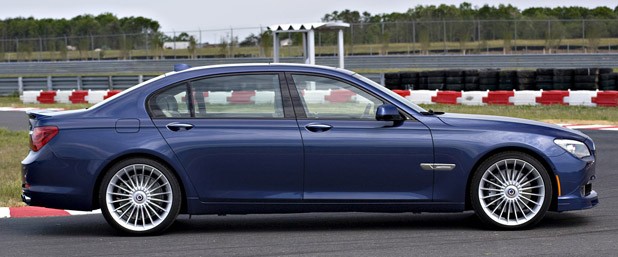
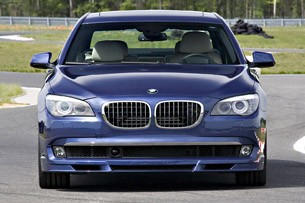
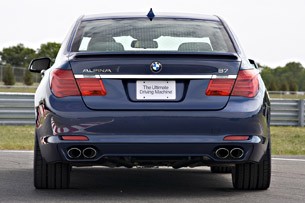
Inside, the changes are also low-key. Stepping across the doorsills one sees the trick plates with "B7" illuminated in blue. The gauges are also blue faced (Alpina's signature color) and sport red needles. Available wood trims include a piano black finish and a pleasing Myrtle Burl wood that's harvested on the West Coast of the U.S. The interior features black suede-like upper trim, adding to the B7's sportiness, while a small plaque by the sunroof switches identify the car as a true Alpina.
Another Alpina design cue is the steering wheel. The rim is the perfect diameter and thickness, complete with buttons for up and downshifts. The Alpina system works well, if just slightly better than some of the buttons Porsche currently uses on its models. Another Alpina characteristic of the wheel is the rim's parallel – as opposed to cross-stitched – sew pattern holding the leather in place. Bovensiepen explained that he and his father like the parallel stitches better as they create a smoother grip surface. Again, details.
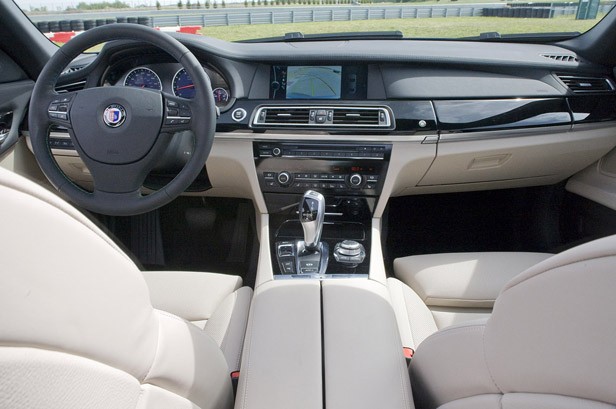
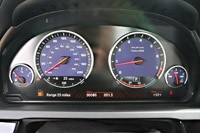
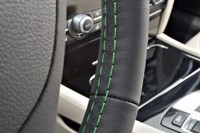
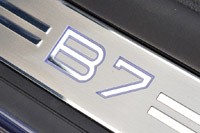
In marked contrast to the restrained exterior and interior changes, Alpina has pulled out all the stops when it came to modifications under the hood.
The modified BMW twin-turbocharged 4.4-liter V8 produces 507 horsepower – 107 ponies more than stock. More importantly, from Andy Bovenseipen's point of view, is the torque – 517 pound-feet of the stuff. A winning race driver in the German Touring Car Championship (DTM), Bovenseipen has firm opinions on torque, "What's important is that the you have torque over a wide range of RPM, it can't be peaky. Torque is important in racing and on the road, because you use it for overtaking."
The company claims a 0-60 mph time of 4.4 seconds, and with an electronically-limited top speed of 175 mph (due to an agreement between European tire manufacturers), overtaking is not an issue in the B7.
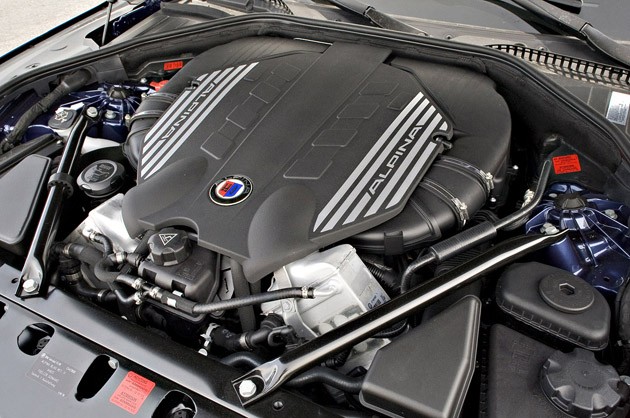
The B7's all-aluminum 4.4-liter V8 is the same mill found in a range of BMW's larger offerings, but each B7 engine is built to Alpina's specifications on BMW's bespoke engine line. Differences include larger – but lighter – turbochargers with a unique vein geometry that squeeze out 14.7 psi of boost (1.0 bar vs. the standard engine's 0.8 bar). The blowers exhale into three air-to-liquid intercoolers, an arrangement that helps maintain maximum airflow even during long lapping sessions at a racetrack. Both larger and additional radiators are used to keep engine and transmission operating temperatures in check and a bigger (2.7-inch) dual exhaust system vents gasses out the back through the rear apron.
While some models in BMW's 2011 7 Series range use ZF's new eight-speed automatic, the B7 is fitted with a heavy-duty six-speed unit sourced from the previous-generation 7. Alpina's Kris Odwarka noted, "Right now we can't get the durability out of the new transmission that our application demands. The six-speed is robust, and it delivers the performance we're looking for. Shifts happen in just 190 milliseconds, which is quick even for a dual-clutch gearbox."
For those expecting the B7 to be a fuel swilling pig, even with 25-percent more power than the stock 750i, the B7's EPA rating matches the 750i's mileage at 14 mpg city, 21 mph highway. The greenies aren't going to love it, but they can't (completely) demonize it, either.
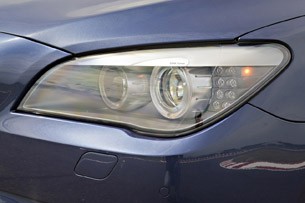
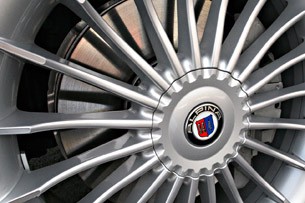
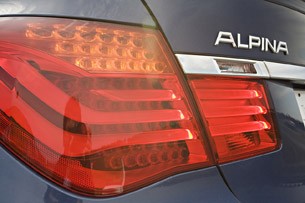
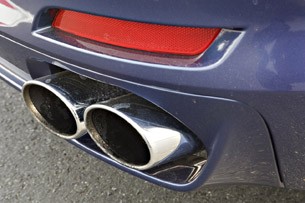
The chassis and suspension received the same level of attention that went into the powertrain. Alpina vastly altered the programming of the standard 7-Series' adjustable suspension, with the Dynamic Damping Control modes of Comfort, Normal and Sport being tweaked to meet their exacting specifications. The Comfort model smoothes out rough, tiresome road surfaces to deliver a ride that befits the character of a luxury sedan, while toggling into Sport or Sport Plus reveal the better side of the B7's personality. The throttle, shift and steering responses sharpen to a point that's uncharacteristic of a sedan of this size. Because of Andy's DTM experience, in certain situations, the electronic safeguards allow the rear tires to slip six to eight percent, meaning the B7 can be driven on the throttle. (We're not sure how to write "YeeHaw!" auf Deutsch, but you get the idea.)
Riding at the end of a double-wishbone front, and multi-link rear suspension, huge Michelin Pilot Sport 2 tires attach the B7 to the road surface (245/35R21 front, 285/30R21 rear). Inboard of the tires are half-shafts and brakes lifted from the armored version of the V12 760i. Special oversized pads are unique to the B7.
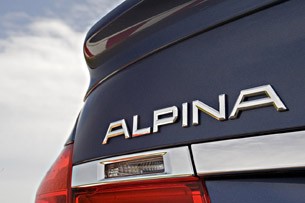
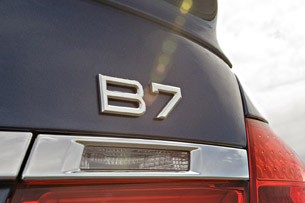
Right about now you're probably wondering, "So how's it all work?" Damn fine. After having the opportunity to drive in a variety of new 7-Series, the B7 reveals itself as exceptional.
On the road when driven as a normal car (as normal as any 7-Series can be), the Alpina performs flawlessly. In either Comfort or normal suspension modes, the ride is calmly controlled and fluid, not harsh. Other characteristics of the big 7 apply to the Alpina variant.
However, step into the throttle and everything changes. The big sedan suddenly feels like a muscle-bound 5-Series. As things start to happen faster, the B7 somehow seems to shrink in physical size and weight, loosing hundreds of pounds from its 4,564-pound curb.
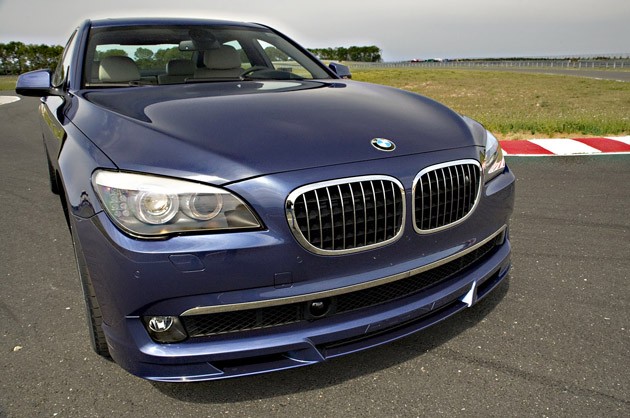
The B7's 507 horsepower has something to do with the sensation. Once you uncork the power genie, it's nearly impossible to put it back in the bottle. It comes on in a turbine-like rush that didn't trail off even as we crested 130 mph and doesn't begin to trail off until the red speedo needle swings past 160.
BMW also gave us the opportunity to drive the B7 at the New Jersey Motorsports Park. We drove it on the course called Lightning, and were easily hitting the same speeds as when piloting a 2011 M3. On one straightaway, we regularly crested 130 mph, at which point we tromped heavily on the brakes. The B7 handled everything with ease.
Andy Bovenseipen also gave us a ride around Lightning. It's always a thrill to ride with a racer, because they attack the track with unbridled vengeance. Compared to our smoother, gentler driving style, Bovenseipen drove deeply into corners and braked with such force that our bodies threatened to fly through the windshield. At several points his braking was so brutal that the seatbelts forcibly retracted in response to the dynamic sensors anticipation of a head-on collision. (The B7 we drove on track was a development car, and this sensor error has reportedly been expunged from production units.) He then threw the car toward the apex and hammered the throttle to the floor until he needed to hit the brakes with the same Herculean force. The B7 responded to its creators' commands without missing a cue. Out on the track, a standard BMW 7 Series would have been left in the B7 dust. And that's just what a B7 buyer expects.
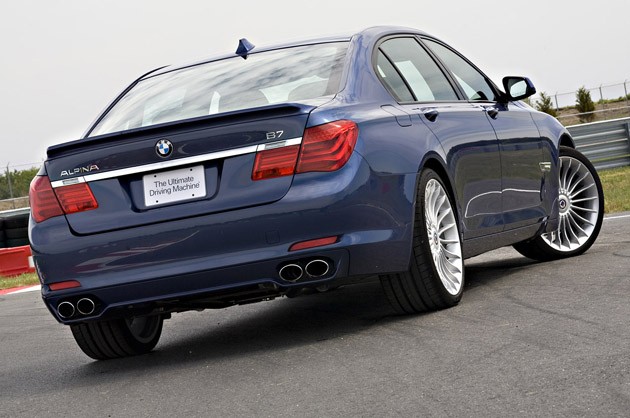
After learning about the B7, it is easy to understand that Alpina isn't just a tuner. Far from it. They work hand-in-hand with BMW on every aspect of the vehicle. Their processes are integrated with BMW's, so there's little wasted energy or resources. This is why Alpina is classified as a vehicle manufacturer rather than an aftermarket firm. Here in the States, vehicle registrations show the manufacturer as BMW Alpina, even though Alpina's models are sold and services at BMW dealers.
Annual production of about 1,000 units will see about half come across the Atlantic. If you must have the best 7-Series ever, get to your local BMW dealer soon with a deposit. They're likely to get just one B7 per model year and with a the price of the standard wheelbase B7 starting at a tidy $122,875, there's a good chance it's already gone.
Second Look: 2011 Alpina B7
Our man Roy has it right – the Alpina B7 is simply astounding in its ability to mix limo-like comportment with the top-flight handling of a smaller sports sedan. That said, I'm still having trouble warming to some of the adjustments Alpina has wrought.
While I like the new steering wheel, the model-specific paddleshift buttons are a bizarre and unwelcome change from the standard 7 Series. Alpina's manual cogswap solution is to fit a pair of tiny rubber-covered buttons to the rear of the wheel (think: Oxford shirt button-small), and while that's fine while on the straight-ahead, it's less than ideal during aggressive cornering maneuvers when your hands need to find them easily.
Surprisingly, the massive stagecoach alloys and watchband tires don't kill the ride – even on Detroit's mangled city streets – and they resist high-speed hydroplaning remarkably well. Better yet, they offer massive grip and a surprising amount of feel. I must admit, however, that while I'm generally a fan of Alpina body modifications, I'm not sure how I feel about the B7's lip spoiler or its aforementioned alloys, which err on the flashy side of acceptable.
Still, there's no denying that the 7 Series is among the premier handlers of the executive car class, and the changes Alpina has made to the suspension just plain work, allowing you to funnel as many of the 4.4-liter V8's 507 horsepower and 517 torques to the ground as you'd like in nearly every situation.
Accelerating a big body as quickly and seamlessly as the B7 routinely does can result in a surprising turn of speed. It simply doesn't feel like you're accelerating to 60 mph in 4.4 seconds because you're surrounded by a living room's worth of fine furnishings and technology. It's likewise dangerously easy to wind up with three digits looming back at you on the head-up display when all you meant to do was pass a doddering semi in the middle lane. Thankfully, the B7 is also fitted with equally stunning brakes, along with top-notch adaptive cruise control that's useful if you lack the willpower to keep off the throttle.
All-in-all, the B7 is one hell of an exclusive executive express – but then again, so is the less costly 7-Series.
– Chris Paukert, Executive Editor
Photos by Rex Roy / Copyright ©2010 Weblogs, Inc.



Sign in to post
Please sign in to leave a comment.
Continue